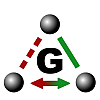2 #ifndef GGL_CHEM_AP_NSPDK_HH_
3 #define GGL_CHEM_AP_NSPDK_HH_
11 #include "sgd/svmmodel.h"
13 #include "nspdk/GraphClass.h"
80 AP_NSPDK(
const std::string & modelID );
152 std::vector< std::pair< RingList, nspdk::SVector > >
168 std::vector< std::pair< RingDescriptor, RingWeightVec > >
284 ,
const std::string edgeLabel
285 ,
const std::string ringFlag );
298 #include "ggl/chem/AP_NSPDK.icc"
